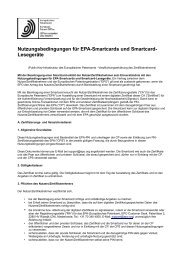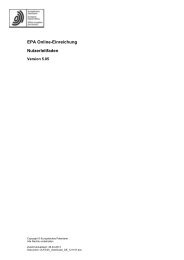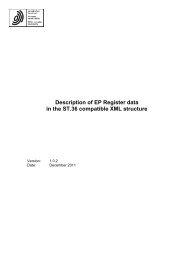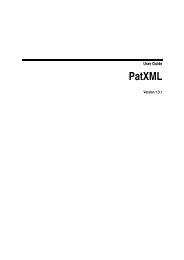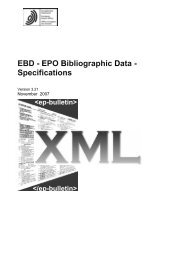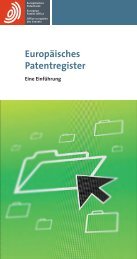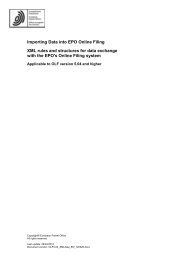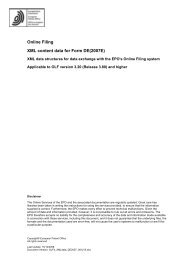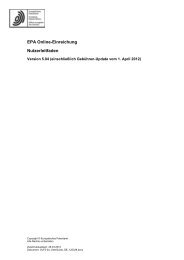Character set & entity references - EPO
Character set & entity references - EPO
Character set & entity references - EPO
You also want an ePaper? Increase the reach of your titles
YUMPU automatically turns print PDFs into web optimized ePapers that Google loves.
<strong>EPO</strong> <strong>Character</strong> <strong>set</strong> and <strong>entity</strong> <strong>references</strong> Version 1.0a, October 1995<strong>EPO</strong> CHARACTER SET AND ENTITY REFERENCESIntroductionOne of the most common problems in data transfer between computer systems, which may be thesame or completely different systems, is whether or not they ‘speak the same language’ at the mostbasic level - the character <strong>set</strong> level used to encode data. A character <strong>set</strong> is:"a <strong>set</strong> of characters that is handled by a specific machine. The <strong>set</strong> usually includes theEnglish alphanumeric characters, special characters and operation characters, all of whichare graphics characters, and various control characters. Graphic characters thus denote aprinted mark or a space while control characters produce some particular effect."A character <strong>set</strong> is contained in a code page. The simplest code page, which is an internationalstandard, is ISO 646: 1983 IRV (International Reference Version). However, this character <strong>set</strong> is sobasic that to utilise it in an environment such as the <strong>EPO</strong> would mean the substitution of manycharacters, such as accented characters, with <strong>entity</strong> <strong>references</strong> (explained below).Probably the most common code page of characters used on computers is ASCII (American StandardCode for Information Interchange), which, in its 7-bit version (128 characters), is almost identicalwith ISO 646. However, when people talk about ASCII they almost always mean extended ASCII -an 8 bit character <strong>set</strong> of 256 characters. This character <strong>set</strong> is more useful, to the <strong>EPO</strong>, because itcontains, for example, accented characters. The picture is complicated further in that there aredifferent code pages for extended ASCII, especially on IBM compatible PCs. Here the most commonare known as code pages 437 and 850. Code page 850 is used in the <strong>EPO</strong> because it is multilingualand, therefore, has more accented characters for so-called Swiss-German keyboards; but thecommonest code page is probably IBM code page 437. In creating the character <strong>set</strong> used by the <strong>EPO</strong>we have taken this fact into account and ‘mapped’ our base code page to be compliant with ASCII437 and 850.Most <strong>EPO</strong> computer systems and projects process data on the <strong>EPO</strong>’s IBM 9000 series mainframe -one of the code pages on this system is IBM EBCDIC (Extended Binary Coded Decimal InterchangeCode) Code Page 500. This is an internationally recognised code page for EBCDIC. In re-designingthe <strong>EPO</strong> publication system we have decided to use this code page as it is the most convenient to usein the <strong>EPO</strong> environment (most, if not all, <strong>EPO</strong> workstations can display and print the characters inthis code page).However, not all the codes on code page 500 are used in the publication systems of the <strong>EPO</strong>; because,in order to maintain compatibility between EBCDIC codes and IBM ASCII 437/850 codes, code page500 has been reduced to those codes which have a one-to-one relationship with code pages 437/850.(This means that in a straightforward EBCDIC to ASCII conversion all characters will be convertedcorrectly). These reduced tables are shown below. The reduced code page 500 will, therefore, be thebasic code page for the character coding of:$ EP A and B patent documents$ EP Bulletin$ Bibliographic data (based on EPASYS data)Please note: This document refers only to data processed by the ELPAC projects and no otherprojects within the <strong>EPO</strong> such as <strong>EPO</strong>QUE, EPASYS, DOCDB, BACON, etc. These projects havetheir own character <strong>set</strong>s and formats.All DATIMTEX data (EP applications and specifications) will be converted to this code page - at theend of 1995 this will amount to about 20 Gbytes of data.Page 3



